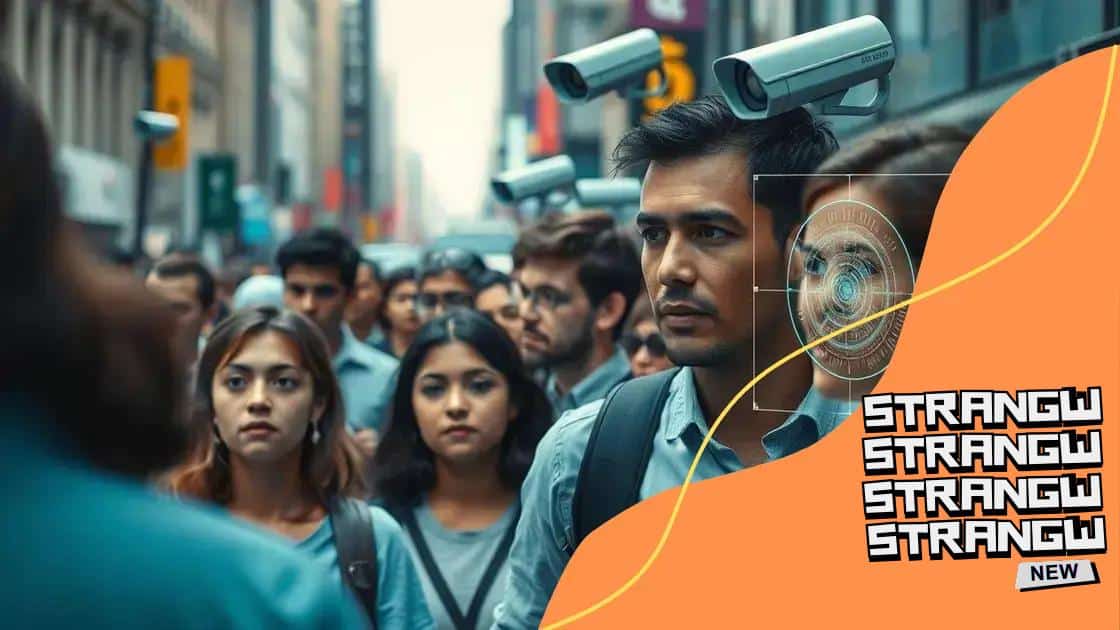The role of facial recognition in enhancing public safety

The role of facial recognition in enhancing public safety includes quick identification of suspects, effective crime prevention, and promoting security at public events, while addressing privacy and ethical concerns remains essential.
The role of facial recognition in enhancing public safety is becoming increasingly significant in urban areas. Have you ever wondered how this technology impacts crime prevention? In this article, we’ll explore its implications for our daily lives.
Understanding facial recognition technology
Understanding facial recognition technology is crucial as it becomes a part of our daily lives. This technology uses algorithms to identify or verify a person’s identity by analyzing their facial features. But how does it work, and what does it mean for public safety?
How Facial Recognition Works
Facial recognition systems capture images of individuals and convert them into data. This data includes unique features such as the distance between eyes, the shape of the jawline, and other characteristics. Once captured, the system compares this data against a database to find matches. This process happens quickly, often in seconds.
Advantages of Facial Recognition
- Enhanced Security: It helps increase security in public places.
- Crime Prevention: Law enforcement can identify suspects quickly.
- Efficiency: Saves time in searching for individuals in large crowds.
With these advantages, facial recognition technology is a powerful tool in our fight against crime. Yet, many people ask, what about privacy? This remains a hot topic of debate within society.
As technology advances, the *potential* uses for facial recognition are expanding beyond just security. Retailers are starting to use it to recognize loyal customers and tailor services to them. This shift signifies a growing trust in using technology responsibly.
Concerns and Challenges
Despite its benefits, many individuals raise concerns. Issues around privacy, bias, and data security are prevalent. It’s essential that as we continue to implement this technology, we also consider ethical standards and regulations to protect citizens’ rights. Balancing safety with privacy is not easy, but it’s crucial for responsible implementation.
Moreover, continuous education on how facial recognition works is vital. As more people understand the framework behind this technology, they can engage more actively in discussions about its use and limitations.
In conclusion, understanding facial recognition technology opens up conversations about its benefits and challenges. As public safety continues to evolve, staying informed about these advancements enables us to navigate the delicate balance between security and individual rights.
How facial recognition aids law enforcement
How facial recognition aids law enforcement is an important topic as cities turn to technology to enhance safety. This system offers powerful tools for identifying suspects and solving crimes efficiently.
Identifying Suspects Quickly
Facial recognition technology allows officers to identify individuals in real-time. When a crime occurs, police can use surveillance cameras to capture images of suspects. By processing these images through facial recognition systems, they can quickly narrow down potential identities. This speeds up investigations and often leads to faster arrests.
Case Studies of Success
- In many urban areas, facial recognition has helped in solving theft cases.
- Some police departments report a significant decrease in public disturbances after implementing this technology.
- Facial recognition has assisted in locating missing persons efficiently.
These case studies show how effective facial recognition can be in law enforcement. By harnessing technology, officers can respond more quickly and accurately to incidents. With detailed data, they can analyze crime patterns and adjust their strategies accordingly.
However, the technology does not come without challenges. Issues like false positives can arise, leading to innocent people being wrongly identified. It’s vital for law enforcement to use this technology responsibly and pair it with solid investigative work.
Despite concerns, facial recognition remains a game-changer for many police forces. The balance between utilizing modern tech and ensuring civil liberties is crucial. As policies evolve, ongoing dialogue about ethics and privacy becomes increasingly necessary.
Public concerns and ethical considerations

Public concerns and ethical considerations play a crucial role in the discussion about facial recognition technology. As this technology becomes more prevalent, it raises questions about privacy, bias, and civil rights.
Privacy Issues
One of the primary concerns is the potential invasion of privacy. Many people worry about being monitored without their consent. Surveillance cameras equipped with facial recognition can track individuals in public spaces, leading to feelings of being watched. This can create a chilling effect, where individuals may alter their behavior due to the belief they are being constantly observed.
Bias and Discrimination
- Studies show that facial recognition systems can be less accurate for certain demographics, such as people of color and women.
- This bias can lead to unfair treatment in law enforcement and security situations.
- Ensuring the technology is unbiased is essential for public trust.
The ethical implications extend further. Misidentifications can have serious consequences, such as wrongful arrests. It’s vital to continuously review and enhance the algorithms used in facial recognition to minimize these risks. Many advocates argue that regulations should be in place to ensure that this technology is used responsibly and ethically.
Engaging with the community and addressing these concerns directly is also important. Public forums and discussions can help educate citizens about how facial recognition works and how data is handled. Building transparency can mitigate fears and increase acceptance. People need to feel that their rights are protected, especially when it comes to such surveillance technology.
Ultimately, navigating these concerns and ethical considerations is vital for the future of facial recognition technology. Policymakers and companies must work together to create frameworks that prioritize public safety while respecting individual rights.
Case studies of facial recognition in action
Case studies of facial recognition in action provide real-world examples of how this technology is being used effectively. These cases showcase both successful implementations and the lessons learned.
Successful Crime Solving
One notable example is how facial recognition helped solve a string of thefts in a major city. After multiple reports of shoplifting, police reviewed surveillance footage and identified a suspect using facial recognition software. This led to the quick apprehension of the individual, decreasing theft incidents in the area.
Event Security Enhancements
Another case involved a large public event. Organizers used facial recognition to enhance security by screening attendees as they entered the venue. This technology helped identify individuals with outstanding warrants, making the event safer for everyone. The integration of facial recognition not only improved security but also reassured attendees about their safety.
Tracking Missing Persons
- Facial recognition has also been pivotal in locating missing persons. Some law enforcement agencies have utilized this technology to match images of missing individuals with those captured in public spaces.
- This method has successfully led to the reunification of families and closure for many individuals involved.
- The relatively quick identification of missing persons shows the positive impact of technology in urgent situations.
These case studies illustrate the potential benefits of facial recognition technology in various applications. However, they also highlight the importance of ethical usage and proper implementation. As these examples show, while facial recognition offers significant advantages, it must be paired with careful thought to privacy and civil rights.
Future of facial recognition in public safety
Future of facial recognition in public safety holds great promise as this technology continues to evolve. Innovations in artificial intelligence and machine learning are pushing the boundaries of how facial recognition can be applied to enhance safety in communities.
Improved Accuracy and Reliability
One of the most significant advancements is the improvement in accuracy. New algorithms are being developed to reduce false positives and enhance recognition rates across different demographics. This will lead to more reliable applications in public safety and greater trust from the community.
Integration with Other Technologies
Facial recognition technology will likely be integrated with other systems such as smart surveillance cameras, drones, and AI analytics tools. This smart integration can create a responsive and interactive public safety system. For example, connected devices may be able to communicate in real-time, providing law enforcement with immediate data to respond to incidents more effectively.
Ethical and Regulatory Challenges
- As this technology advances, ethical considerations and regulatory frameworks will become even more critical.
- Ensuring privacy and civil liberties will remain a fundamental concern for communities.
- Governments and organizations will need to establish clear guidelines to use this technology responsibly.
The future landscape of public safety may also include community engagement initiatives that help citizens understand how facial recognition works. Transparency can build trust and address concerns about privacy and surveillance. Public forums can facilitate discussions, allowing citizens to voice their opinions and suggest policies.
Ultimately, the emphasis on responsible innovation will shape the trajectory of facial recognition in public safety. Collaboration between technology developers, government, and the public can leverage this powerful tool while maintaining respect for individual rights.
FAQ – Frequently Asked Questions about Facial Recognition in Public Safety
What is facial recognition technology?
Facial recognition technology uses algorithms to identify or verify a person’s identity by analyzing their facial features.
How does facial recognition enhance public safety?
It helps law enforcement identify suspects quickly, assists in solving crimes, and enhances security at public events.
What are the concerns related to facial recognition?
Privacy issues, potential bias in recognition accuracy, and ethical considerations regarding surveillance are some major concerns.
What is the future of facial recognition in public safety?
The future may include improved accuracy, better integration with other technologies, and the establishment of clear ethical guidelines.





